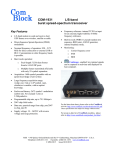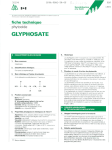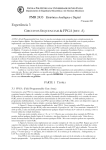Download VLSI Design and Implementation of ASICs for the Security
Transcript
FACULTY OF ENGINEERING – INTEGRATED CIRCUITS LAB ELECTRONICS AND COMMUNICATIONS DEPARTMENT VLSI DESIGN AND IMPLEMENTATION OF THE BASEBAND SECURITY CORE FOR BLUETOOTHTM WIRELESS COMMUNICATION SYSTEM STANDARD SUPERVISOR PROF. DR. HANI F. RAGAAI BY AHMAD ABDELHAMEED & SAMEH ASSEM IBRAHIM 1. ABSTRACT An FPGA solution for the Bluetooth security measures has been designed and implemented with 45 I/O ports and a maximum clock frequency of 66MHz on Xilinix Virtex FPGA. We could achieve a single chip performing the key generation and handling for authentication and encryption algorithms in addition to it’s own built-in pseudo random number generator. The encryption core only was implemented and tested on Xilinix Spartan. All the simulation and back annotation results were consistent with the sample data available within the Bluetooth specification. 2. SYSTEM OVERVIEW Bluetooth is a new promising technology. The expectations for Bluetooth are huge. Analysts’ mark projections place Bluetooth-enabled products in the “next big thing” category, with sales expected to top a billion units by 2005. It is a technology to replace cables between any electronic devices. The technology is an open specification for wireless communication of data and voice. It is based on a low-cost short-range radio link, built into a 9 x 9 mm microchip, facilitating protected ad hoc connections for stationary and mobile communication environments. The need for Bluetooth Security measures emerged from the fact that the standard works in the ISM band. Many applications use this free band, which renders the environment noisy that data can be received from unauthorized users and the transmitted data can suffer from eavesdropping as well. To avoid this, different security measures have been taken into consideration in Bluetooth specifications. Baseband Bluetooth Security has three main functions: Key generation and handling, Authentication and Encryption. The design was targeted to perform the three functions. The order of running these functions and the interactions between them is a higher level operation. However we managed to design a controller to perform these functions for self consistency. Some or all of these functions can be implemented in software but to increase speed of processing we aimed to get them hard-wired. Bluetooth is finally a single chip transceiver. This implies to design the security core as an ASIC to be embedded in that chip. However for testing and verification purposes an FPGA based design was our aim. Verification was based on the sample data provided in the Bluetooth specifications. Also the different algorithms used were implemented in software to generate random test vectors to be used. 3. SOFTWARE USED 1. FPGA Advantage: Renoir was used for design entry. VHDL codes, block diagrams and state diagrams were all entered through it. The only problem we faced was combining the work of both of us together. This forced us to rename all the libraries and files made to work together after working separately. 1 Modelsim was used for simulation and backannotation. Inputs were taken from MATLAB and outputs were compared with MATLAB outputs for verification. Leonardo was used for synthesis and Xilinix FPGA’s were targeted. 2. Xilinix Alliance: That was the software used for placement and routing on the Xilinix FPGA’s and programming them as well. 3. MATLAB: It was used to implement the algorithms in software and to generate testbenches for verifications. 4. THE IMPLEMENTED BLUETOOTH SECURITY CORE According to the Bluetooth specifications ver.1.1, three main functions must be implemented within the security core. These are: 1. Key generation and management. 2. Authentication. 3. Encryption. 4.1. KEY GENERATION AND AUTHENTICATION Four different algorithms are used to achieve these functions. These are E1 (for authentication), E21 and E22 (for link and initialization key generation) and E3 (for encryption key generation). The four algorithms depends on an algorithm called Ar and a slightly modified one called Ar’. Both Ar and Ar’ are based on the SAFER+ encryption algorithm. This algorithm consists of 8 encryption rounds consisting of non linear operations. Each round has a 128 bits plaintext and 2 subkeys provided by a key scheduler. A final subkey is used for some extra operations. 4.1.1. SAFER+ ENCRYPTION ROUND IMPLEMNTATION It was designed using the block diagram editor in Renoir. The small blocks in it like the modulo-256 adder, the 8-bit XOR, PHT and Permute were designed as VHDL codes. But the exponential function [(45x mod 257) mod 256], where x ranges from 0 to 255, and the logarithmic function [(log45(x) mod 257) mod 256], was very difficult to be implemented as an algorithm in VHDL. MATLAB also was unable to calculate the function as well. So the values were written as a look-up table (LUT) in VHDL. The round was designed in a pure combinational way made up of these blocks just as stated in the specifications (figure 1). The advantage in this way is the single clock needed to do all the round calculations. Unfortunately, the implementation of the overall chip shows how large its area was. The round was redesigned to be a sequential one to avoid the repetition of look-up tables, which increases the area so much. The new design made use of a controller entered as a 10 states finite state machine (FSM) with multiplexers and a demultiplexer as shown in figure 2. The idea of the controller was to select each clock a different 16 bits of the input and the two 2 subkeys. Thus we are processing 16 bits per clock and thus only one log LUT and one exp LUT. The order of the 2 octets in the 16 bits were reversed each clock to follow the specifications. Thus the controller was designed to control multiplexers to do this function. At the end a certain output is produced to announce the end of the round. This new design enabled us to reduce the core area by about 25%. But yet the speed was reduced, as 8 clocks are needed now to perform round calculations. Since it works on 128 bits a round therefore this is not a big problem. rou nd_ inp ut : (127:0) output @ + k2r_1 : (12 7:0) round_input e log + @ pass @ + + @ @ + + @ @ + + @ @ + + k2r : (12 7:0) @ k2r_1 e log log e e log log e e log log e e log log e + @ @ + + @ @ + + @ @ + + @ @ + k2r PHT PHT PHT PHT PHT PHT PHT round_control PHT reg16oct permute PHT PHT PHT PHT PHT PHT PHT PHT PHT PHT PHT PHT PHT PHT PHT PHT PHT PHT PHT PHT PHT PHT PHT PHT PHT PHT PHT permute PHT PHT PHT PHT permute PHT PHT PHT PHT PHT PHT permute PHT PHT PHT PHT PHT PHT permute permute PHT PHT PHT PHT PHT PHT PHT PHT PHT PHT PHT PHT PHT rou nd_ output : (12 7:0) round_output Figure 1: Combinational SAFER+ round (Renoir) Figure 2: Sequential SAFER+ round (Renoir) 4.1.2. SAFER+ KEY SCHEDULE The key schedule as needed in the specifications is shown in figure 3. Seventeen Bias words are needed in the key scheduler. They were written in VHDL format as a ROM. On the other hand, a VHDL code was written for the Octets summer to XOR the 8 bits of all the 16 octets and for the Rotator to octets 3 bits left. The selection of octets to be added to the bias words was done in the Selector block diagram by certain connections. The bias ROM with seventeen 128 bits outputs at the same time was of no use since only two keys are needed per round. Thus the design was turned to a sequential one to reduce the area giving the required 2 subkeys per round. No additional controller was added as the 3 SAFER+ controller was used. See figure 4. Yet new blocks were needed such as a register written in VHDL for feedback and Octets rotator to rotate the octets among themselves for appropriate selection of octets to be added. 4.1.3. AR/AR’ BLOCK A controller entered as a finite state machine using the state diagram editor was used to manage the eight rounds and also the feedback paths to differentiate between Ar and Ar’. The only difference is that in the Ar’ function the input of round 1 is added to the input of the 3rd round. k1 octets_sum feedback + + + + + + + + + + + + + + + + ki : (127:0) octets_rotate octets_circulate + + + + + + + + + + + + + + octets_rotate octets_circulate + + + D Q Figure 3: SAFER+ key schedule for 128 bit key CLK Q + kii : (127 + + + + D + + + + + + + + + + k17 sel : (2:0) reg136 bias_rom Figure 4: Key scheduler(Renoir) 4.1.4. E1/E21/E22/E3 BLOCK Another controller also entered using the state diagram editor was implemented to use the SAFER+ block as any of the required algorithm depending on the value of a two bits input. The final block diagram is shown in figure 5. 4.1.5. E1/E21/E22/E3 BLOCK SIMULATION The simulation of the design depended mainly on 2 things: An example given in the paper of SAFER+ nomination as an AES candidate to simulate the Ar/Ar’ block, and the sample data in Bluetooth specifications to simulate the overall block. Every small part was simulated by itself first and they all seemed to work properly. All the blocks should have been all back annotated but only the small ones were back annotated and worked properly. Others didn’t fit except on 4 large FPGA’s not installed on Xilinix software at our hands. Then it was time to simulate the algorithms block depending on the sample data and whether they are working correctly or not. To be sure that the block was working well for other inputs too, we started to write a test bench for the design. A MATLAB GUI program creates random inputs, evaluates the outputs of E1, E21, E22 and E3 algorithms, puts the inputs in a test vector and the outputs in a file and finally compares this output file with another one produced by ModelSim. key : (127:0) ad_PIN_COFu : (47:0) bdadb_COFl : (47:0 Rand : (127:0) Ran d(7: 0) : (12 7:0 ) a : ( 7: 0) c : ( 7: 0) b : ( 7: 0) ou tput _4 : (7: 0) e_ type(0) : (1: 0) Concatenation Ran d(12 7:8 ) :inp (12ut7:0 : ()7: 0) in_ 2 : (12 7:0 ) offset in1 : (12 7:0 ) in2 : (12 7:0 ) sel ou tput : ( 12 7:0 ) ou tput _7key : (12 : ( 7:0 12 7:0 ) ) in1 : (12 7:0 ) in2 : (12 7:0 ) sel in2 : (12 7:0 ) ou tput _9 : (12 7:0 ) sel ou tput : ( 12 7:0 ) ou tput : ( 12 7:0 ) sel ou tput : ( 12 7:0 ) y dash ou tput : ( 12 7:0 ) ou tput _3 : (12 7:0 ) SAFER dash dash e_ type : ( 1: 0) done start_algo start_algo ou tput _1 : (12 7:0 ) in2 : (12 7:0 ) rst rst e_type : (1:0) in2 : (12 7:0 ) ou tput : ( 12 7:0 ) plain _text : ( 12 7:0 ) key : ( 12 7:0 ) rst sel in1 : (12 7:0 ) e_ type(1) : (1: 0) ou tput _2 : (12 7:0 ) rst in1 : (12 7:0 ) y ou tput : ( 12 7:0 ) ou tput _8 : (12 7:0 ) in2 : (12 7:0 ) sel in_ 2 : (12 7:0 ) in2 : (12 7:0 ) e_ type(0) : (1: 0) sel ou tput : ( 12 7:0 ) ou tput _7 : (12 7:0 ) in1 : (12 7:0 ) y in1 : (12 7:0 ) e_ type(1) : (1: 0) z in2 : (12 7:0 ) in1 : (12 7:0 ) e_ type(0) : (1: 0) algo_control clk done go clk ciph er_ text : ( 12 7:0 ) ciph er_ text : ( 12 7:0 ) go done go key_change key_change Ran d : ( 12 7:0 ) z end_algo inp ut1 : (12 7:0 ) clk ou t_3 : (12 7:0 ) ou t_2 : (12 7:0 ) end_algo end_algo ou tputinp : ( ut2 12 7:0 : (12 ) 7:0 ) reg128 xor_128 ou tput _5 : (12 7:0 ) inp ut2 : (12 7:0 ) ou tput _6 : (12 7:0 ) ou tput : ( 12inp 7:0ut1 ) : (12 7:0 ) add_128 algo_out : (127:0) Figure 5: The block diagram that can be used for E1, E21, E22 and E3 algorithms (Renoir) Figure6: The GUI MATLAB program written for testbench generation 5 4.2. Encryption The encryption is carried out with a stream cipher called E0 that is re-synchronized for every payload. E0 consists of three parts. One part performs the initialization where the input bits combined in an appropriate order and shifted them into the four LFSRs used in the second and the main part, the key stream generator. The third part performs the encryption and decryption. The key stream bits are generated by a method derived from the summation stream cipher generator attributable to Massey and Rueppel. This is shown in figures 7 and 8. Figure 7: stream ciphering with E0 Figure 8: the Encryption engine (Renoir) The system uses linear feedback shift registers (LFSRs) whose outputs are combined by a summation combiner. The output of this combiner is the key stream sequence, or, during initialization phase, the randomized initial start value. There are four LFSRs of lengths L1 = 25, L2 = 31, L3 = 33 and L4 = 39 , with a total length of 128 and primitive feedback polynomials with a Hamming weight of five, a reasonable trade-off between reducing the number of required XOR gates in the hardware realization and obtaining good statistical properties of the generated sequences. 6 4.2.1. LFSR LFSRs sequence through (2N –1) states, where N is the number of flip-flops in the LFSR. A value of all "1’s" is illegal in the case of an XNOR feedback, and a value of all "0's" is illegal for XOR feedback. There are two implementation styles of LFSRs, Galois implementation (figure 9) and Fibonacci implementation (figure 10). The first one was chosen as it offered shorter time, smaller XOR size and modular design for best fitting in our FPGA. Although the early first simulation showed that there was no need for set or rest inputs for the D-flip flop, the back annotation showed it not working due to the presence of un-initialized bits. Figure 9: Galois Implementation Figure 10: Fibonacci Implementation After the first 240-cycle, the LFSRs must be loaded with the last generated 128 bits. This means an added multiplexer to each bit of the LFSRs. There were two choices which one come first: the MUX or the DFF? Both choices has worked for the first 240 cycles successfully but there was a delay of one clock cycle when performing the parallel loading for the last 128 generated bits when taking the input to the MUX first. So, the next configuration was chosen. When “LOAD” (a control output from the FSM controller inside E0) is low, the INPUT passes to OUTPUT, but when it is high; the parallel loading of the last 128 generated bits passes. As long as “INIT” (a reset input controlled by a higherlevel controller outside E0) is high, OUTPUT will stay low. It is clear that the structural way was chosen for implementing the LFSRs as it gives the most perfect results as we are targeting the basic building blocks on the FPGA. The behavioral one can also work but the synthesis with Leonardo showed additional gates like AND & OR gates. The incoming bits must fill each LFSR first before closing its own feedback switch and here rises a problem: how to design a feedback switch to be closed after 25 clock cycles for the LFSR1 for example? An AND gate is added in the feedback path as shown to perform the AND operation on the feedback signal and a control signal “FB25” coming from the FSM of the encryption engine: when it’s high, the switch is closed and the incoming feedback signal will pass. If “FB25” is low, the output of the AND gate is low (logic ‘0’) and going to the input of the XOR gate at the input of the LFSR to be XORed with IN25, which will pass to the first bit of the LFSR. The same idea was used for the other LFSRs. 7 Figure11: the first LFSR (Renoir) 4.2.2. INPUT SHUFFLING Let’s suppose that the KC, BD_ADDR and the CLK26-1 are coming in serial to reduce the number of pins. A finite state machine can be used with an 8 bits counter while using a 3 x1 multiplexer at the input of each LFSR. This method was proved to be complicated and slow and thus another methodology is used as long as this encryption engine shares the same chip with other security algorithms. E0 will get the Key from E3 as a 128 bits parallel output. We get the Bluetooth device address as a serial bit stream to be stored in a shift register shared between all the blocks and then E0 will get it as a parallel input. The CLK26-1 is coming out of the Bluetooth counter as a parallel output too. Then, two registers of the length 49 and two of the length 55 are needed. A parallel loading will start when a control signal “Load_reg” comes from the FSM of E0 while shifting is disabled. After that, the control signal (Load_reg) will go low and shifting will start to the inputs of the four LFSRs. The parallel load will guide the incoming parallel inputs to their positions. After all the bits being shifting in, we have three choices: Insert a switch to disable the XOR gate at the input of the LFSR. A multiplexer should be used too. The switch may come before the XOR gate with the same idea as the feedback switch. Shift all zeros ‘0’ to the input. Both ways 1 and 2 will need more gates and extra control signals for the switches and MUXs and these control signals must be time based. This means additional states in the finite stat machine FSM, which will lead to an additional D flip flop for each extra state. The last idea is used. Shifting the control signal (Load_reg) with the incoming data will work as shifting a ‘0’ after all the bits being shifted in with just adding a wire from the control signal (Load_reg) to the last position of the shift registers. Shifting will not start until (Load_reg) goes to ‘0’. 4.2.3. PARALLEL LOADING At t=240, a parallel loading will be performed to the four LFSRs for the last generated 128 bits at a specified positions to achieve a complicated shuffling. A 128 bits register with enabling and disabling its clock only once is used. At t=240 a parallel load of the contents of this register will be performed on the four LFSRs at the specified positions with an appropriate port mapping. 8 4.2.4. THE FINITE STATE MACHINE We need this controller to manage the operation of different blocks in the Encryption Engine, which can be summarized as follows: 1. Opening and closing of the feedback switches for the LFSRs at different clocks. 2. Resetting the blend registers when all switches are closed. 3. Keeping the contents of the blend register and the end of the initialization step. 4. Perform the parallel loading at the end of the initialization step. It seems simple but it needs a very careful timing design. 7 control signals are needed controlled through the output of an 8 bits counter, which will be reset when an encryption command is issued while no need to stop it. To reduce the power consumption, the clock will be enabled/disabled through an And gate and a control signal according to whether the encryption engine is in use or not. 4.2.5. ENCRYPTION ENGINE SIMULATION Simulation was performed according to “Appendix IV” of the Bluetooth specification, Encryption Sample Data. All the four sets of sample data with 364 clock cycles for each were obtained successfully. Figure12 shows the waveforms obtained from Modelsim compared to the expected results from the first set of sample data. The waveform is shown around t=240 when the parallel load is performed. For the purpose of simulation only, a 9-bits counter is added to work in parallel with the 8-bits counter already exist in the design to show the clock number up to 364 which is the last clock in the sample data and thus helps me to trace all the clocks in all the sets. A visual C++ program was also used to verify some additional samples and the results were also O.K. 9 Figure 12: simulation results from ModilSim compared to the sample data taken from the Bluetooth specification 4.3. BLUETOOTH RANDOM NUMBER GENERATOR: Each Bluetooth unit has a random number generator. Ideally, a true random generator based on some physical process with inherent randomness is used. Examples of such processes are thermal noise from a semiconductor or resistor and the frequency instability of a free running oscillator. For practical reasons, a software-based solution with a pseudo-random generator is probably preferable. Clearly, the Link Manager (LM) can use such a generator for various purposes; i.e. whenever a random number is needed. Bluetooth needs 7 different RAND numbers. However, these numbers are to be sent over air in public during Authentication between two devices; these numbers are no more secrets. The most efficient implementation is to use an LFSR, which are the functional building blocks of circuits like the pseudo-random noise (PN) code generator and Gold code generators commonly used in CDMA systems. The PN code has a life time of 23 hours and 18 minutes. With a 3.2KHz BaseBand clock, we can calculate the length of the LFSR required for a single bit random number to be 28 stages. However, different blocks in the Authentication and Key generation algorithm needs the 128 bits random number as a parallel inputs. This forces us to use a 128 bits shift 10 register to store the number first. Actually, this leads to a much longer period besides the extra hardware and the slow operation; we have to wait for 128 clock cycles for the random number to be stored and then perform the parallel input. We have found that we should use a 128-stages LFSR as our random number generator. In addition to the 128 parallel outputs, there is a single bit output to get the random number serially and send it outside our chip. When the Bluetooth starts working, a reset signal will force the LFSR to be all zeros. Whenever we need a random number, a command will be issued to make the parallel loading and starts counting 128 serially outputs at the same time. We have built some controlling blocks to enable or disable the operation of the random number generator according to the situation requires such things. Would that be random? Yes, as long as it is impossible to need two consecutive random numbers. It is also possible to fill this LFSR with a serial number, which is actually the random number coming from the other Bluetooth device. This will lead to more randomness. As a future work, we may make it possible to load our random number generator with any parallel input from LM for example and not just by all zeros. According to the unpublished research done by Wayne Stahnke while he was at Fairchild Semiconductor in 1970, there is a table to define the maximal length sequence L = 2N-1 for LFSRs of length 3 to 168. For the N=128 bits, this is done with feedback at (128,126,101,9). 4.4. The Bluetooth Security Core We thought of designing it to be able to deliver a single chip. Combining the E0, E1, E21, E22 and E3 was not that easy task in the absence of a RAM. Every algorithm depends on the output of other algorithms. For example, E0 gets it Kc from E3, which gets its COF from E1’s ACO or from the BD_ADDR. Again E1 gets its key from either E21 or E22. All of the algorithms need a 128 bits random number and some of the algorithms inputs or outputs have to be sent to the other user. To solve these problems we needed: A complicated controller designed as a FSM but was written in VHDL and entered using Renoir. We believe this controller is doing some of the LM functions. We needed also some shift registers to convert from serial to parallel and vice versa and so we were able to reduce the number of pins greatly. In addition, we needed some multiplexers and registers. Some of the controller' functions are: 1. According to the value of “e_select” entered, it issues some outputs to select the algorithm required as well as opening the correct path. 2. It stops all the operations as long as “en_fb” =’0’ or “load_adr” =’1’ or “load_key”=’1’. All this conditions means that there’s an external input being added serially by the upper layer. 3. It produces the required signals for the start and stop of operations of E0 4. Together with another block written in VHDL called RNG control, it controls the random number as required and stops it whenever an algorithm is running or whenever a random number is being added. 5. It issues ‘start_algo’ required by the algorithm block. 6. It issues outputs that tells the upper layer controller to start saving the output. 11 The multiplexers shown in figure 13 are used to select COF equals to ACO or obtained from the concatenation of BD_ADDR when the used key is a mater one. It is also one of the functions of the controller to do it. Also the and gates shown are used to disable the clocks on the shift registers whenever serial input has finished. The core is now ready to be used with an upper layer controller to correctly input the data at correct times. And correctly set the sequences of algorithms used as needed in different security levels. The pins of the core and their functions are shown in table 1. Pin Name Function Clk To enter the external clock Rst To reset the core Data_in To enter the data to be encrypted Data_out The output of the encrypted data cl26 (26 The 26 bits CL26 input to the encryption engine E0 pins) e_select (3 pins) To select among various algorithms: ¾ “000” : E21 ¾ “001” : E22 ¾ “010” : E1 ¾ “011” : E3 when key used is a master key ¾ “100” : E3 when key used is any other key ¾ “101” : E0 start ¾ “110” : E0 stop ¾ “111” : to be selected after any algorithm. Note that: there are still the upper link manager that determines the sequence of algorithms to be done after each other. And thus it is responsible for putting the values of these pins. Load_adr To start entering the addresses serially set this pin ‘high’ and when finished set it ‘low’ adda_pin An address serial input or pin serial input as well. Addb Another address serial input. Load_key To start entering an external key serially put it ‘1’ else put it ‘0’ key_in The input of the serial key key_out The output of the serial key 12 En_fb Enables the feedback of the pseudo-random generator. Thus when it is ‘0’, no feedback is present and its working as a shift register to have an external random number entered serially. Rand_in The input of the external random number. Rand_out To output the random number used serially Rand_start To indicate the start of the random number used out_start To indicate the start of the output key or SRES Sres_out To output the SRES serially Table 1: The pins of the core and their functions. 4.4.1. THE SIMULATION OF THE CORE: Due to having the pseudo-random generator built in the core, the simulation was a very complicated task as the random number used is not known. But thanks to the rand_start output the random number can be known. Another problem appeared which is the impossibility of simulation of core when doing the E0 tasks due to not knowing the outputs to be taken. That would have been the case for the other algorithms except for the help of the MATLAB code written. So let’s try a sequence and test the core. First we have to generate an initialization key. We start by resetting the whole core. And setting the e_select = ‘001’; the code for E22. also we set load_adr = ‘1’ which means we’ll enter an address and a PIN code serially. But we’ll start this after some time to have a good random number generated. Remember that en_fb should be = ‘1’ for the RNG to operate. Load_key =’0’ cause we don’t have an external key. After running the simulation for sometime , we have to enter the address and the PIN code serially. And after 48 clock cycles setting the load_adr=’0’. To add this data serially we’ll force a clock on both adda_pin and addb pins with double the clock period one starting with a rising edge and the other with a falling one. This would make PIN=’AAAAAAAAAAAA’ and address=’555555555555’. From ModelSim we see the random number used to be =’ 00F4CC003B000003000000000007E000’. Taking these values and running the MATLAB program we get: Kinit= ‘84FC3B8C9F1AE0A237F78D4E51685337’ Now let’s set e_select=’111’ and continue running till we get out_start=’1’ and take the value of K produced. Kinit as produced by ModelSim =‘84FC3B8C9F1AE0A237F78D4E51685337’ which is the same as MATLAB. Now , let’s perform an authentication function. The current link key is Kinit and we have a new random number and the address we’ll take the value already entered. So let’s set e_select=’010’ and then ‘111’ after about 5 clocks. And run the simulation. Notice that en_fb=’1’ , load_adr=’0’ and load_key=’0’ thus the algorithm will run as soon as e_select =’010’. 13 load_key key_in en_fb KEY_IN CLK clk out_start GET_KEY: (128 :1) SAVE_KEY rst rand_in RST EN_FB REG_128 CL K_REG 128 RNG KEY_R EG : (128:1) RAND_IN rand_out RAND_OUT clk ClK RAND : (128 :1) KEY_READY key_out CLK KEY_R EG : (128 :1) RAND : (128 :1) ClK_RNG KEY_OUT_SR KEY_OUT KEY_R EG : (128:1) KEY_R EG : (128:1) clk Q Q clk CLK D EN RST rst rst en_fb start_algo rst ke y : (1 27:0) rst RNGcontrol Rand : (1 27:0) alg o_ou t : (1 27:0) alg o _out( 127:96) : (127:0) key_change key_change out_start algorithm end_algo alg o_out : (127 :0) clk SRES_ IN : (32:1 ) out_start sres_out SRES_READY e _ty pe : (1 :0 ) SRES_SR CLK clk start_algo SRES_OUT clk alg o_ou t(95:0 ) : (1 27:0) ad_ PIN_CO Fu : (4 7:0) bdadb_ COFl : (4 7:0) out_start ad_ PIN_CO Fubd :a (47 db :0) _COFl : (47:0) ACO_ADDR : (48:1 ) REG96 SAVE_ACO ACO_ADDR : (48:1) C1 C1 C1 ACO_REG : (96:1) ADDR_ REG : (48:1) ACO_REG : (4 8:1) controller ADDR_ REG : (4 8:1) ACO_REG : (48:1 ) ACO_REG(9 6:49) : (96:1) ACO_REG(48:1) : (96:1 ) start_algo rand_start RST E_ty p e : (1 0 :) E_ ty pe : (1:0 ) ADDR_REG : (48:1) B1 : (48:1) start_algo e_select : (2:0) ADDR_ REG : (48:1) ADDR_SR E_ sele ct : (2 :0 ) CLK out_start ADDR_ REG : (48:1) ADDR_SR addA_PIN_addB CLK addA_PIN_addB end_algo C1 CLK_ADDR_REG alg o _out : (127 :0) OUTPUT C1 data_in clk load_adr clk RAND_start en_fb en_fb alg o_ algo aout g l_ al out o_ (g 12 al o7 g ( ut _ 11 al out :1 o_ g (20 9:112 11 al ou o_out g ()1 ao_ t::1 g 0 l(3:96) 95 )ou 04 o_out (1 al (::88 g 8)a 2t7:0 o_ (12 7 (:g :80 l79 )ou o_out :(1 (g )7 :7 :a )(12 :0 2 1 (12 tg 7:0 :2 ()al 63 7:0) (127:0 :7:0 ()a :5 5o (12 6 :48 )out )al (12 ): o )(7 (12 : ):0 )7:0 al o_ l:64 ou o_ g tg l(:5ut _ 47 o_ (7:0) g :4 39:32 a o_ ut g 0 l31 ou o_ ((127:0 :2 :23:16 )o (12 t:4 (ut )15 (12 :7:0) ():8 7: (1 7 :0):0 )2 (12 7:0 : ): (1 7 (1 ) :0 27:0 2)7:0) ) load_key load_adr load_key DATA load_adr INIT INIT CLK_Enable CLK_Enable data_out Load_reg Load_reg E0 ADDR_ REG(8:1 ) : (48:1) ADDR_ REG(16:9 ) : (4 8:1) ADDR_ REG(24:1 7) : (48:1) ADDR_ REG(32:2 5) : (48:1) ADDR_ REG(40:3 3) : (48:1) ADDR_ REG(48:4 1) : (48:1) CLK ADDR_ REG : (48:1) CLK clk cl 2cl6(25 26 cl (2 2)cl6:4 (23 26 )cl(25:0) :(1 26(7: :1 cl(25 5 26 6 :8) )(3: :0) 4: ):0 (25 : (25 )(25:0) :0 : :0) (25 ) :0) clk load_adr adda_pin addb cl26 : (25:0) Figure 13: The Bluetooth Security core (Renoir) From ModelSim, we see that the random number used is ‘3D33000EC00000C00000000001F80001’ whereas the BD_ADDR=’ AAAAAAAAAAAA’ and from initialization we know that the current key =’84FC3B8C9F1AE0A237F78D4E51685337’ So taking these values to MATLAB, we get the output equals to ‘E4E3F1F353C5CB21C8AC8C5DB6A45912’ Whereas in ModelSim we get: Algo_out=’ E4E3F1F353C5CB21C8AC8C5DB6A45912’ which is again the same. Now let’s run E3, this is done by setting e_select =’100’ then ‘111’ after about 5 cycles. COF is already known to be equal to ‘53C5CB21C8AC8C5DB6A45912’ whereas 14 the current link key is still ‘84FC3B8C9F1AE0A237F78D4E51685337’ the random number as seen from Kc was ModelSim is equal to equal to ‘001800000000003F000030FFF0003C00’ When these values were entered to the MATLAB program, found to be ‘EE32029B7027864E43A223B430FD240C’. ModelSim gives ‘EE32029B7027864E43A223B430FD240C’ which is again the same. This is enough to clarify that the core is working alright from the simulation point of view.. 4.5. BACK ANNOTATION AND FPGA TESTS: In our design, we have demonstrated how VHDL circuits can be optimized for FPGA targets by adapting descriptions styles to the available resources, such as flip-flops, three-state buffers and others. This affects coding styles for many basic design blocks, such as storage elements, multiplexers and finite state machines. We were Figure 14: Flow unique to Alliance and Leonardo Spectrum targeting Xilinx FPGAs und using Xilinx Alliance Series for performing place and route and timing analysis and then returning to Modelsim for back annotation. Unfortunately, there were none a single block small in size enough to be tested on the available FPGA chip available at our hands; the Spartan S10PC84. Targeting a larger FPGA form Xilinx family was the solution to perform the back annotation with delays on different blocks of the Bluetooth security chip. For the Encryption Engine, it gives correct timing results for all sets of sample data. However, modifications could be made for the Encryption Engine to be tested on S10PC84. The major problem with the Encryption Engine was the 208 bits input signals and their corresponding registers. Only 61 input/output and 392 CLB flip flop were available in the Spartan S10PC84 (the other 256 flip flop cannot be reduced). Although, we could make the back annotation and timing simulation using ModelSim and the simprim library on a larger FPGA and find the results correct exactly for all the sample data comes with the Bluetooth specification, we thought of some clever way to download the Encryption Engine on the S10PC84 and test it experimentally with two choices: 15 1. We can remove the input shift registers and get a serial input directly to the LFSRs. This idea was hard to realize due to difficulties in synchronizing the inputs with the clock. 2. Replacing the input registers with smaller ones. We have noticed that the first and the second sample data are all zeros except for the first three or four bits. And thus, we can replace the large shift registers with smaller ones with the size of 4 bits only. Parallel loading will be performed for the first 4 bits. Then, shifting ‘0’ when all the four bits being shifted into the LFSR. This idea has three advantages: (I) reducing the number of required CLB flip flop from208 to 16, (II) reducing the inputs by the same amount, too, and (III) keeping synchronization between the clock and the shifting procedure. The only disadvantage was the limitation to the first and the second sets of sample data only. In what to follows, we are presenting some results from Leonardo Spectrum, Xilinx Alliance series and the experimental tests. *********************************************** Device Utilization for S10PC84 *********************************************** Resource Used Avail Utilization ----------------------------------------------IOs 32 61 52.46% FG Function Generators 233 392 59.44% H Function Generators 7 196 3.57% CLB Flip Flops 294 392 75.00% ----------------------------------------------Using wire table: s10-3_avg Clock Frequency Report Clock : Frequency -----------------------------------CLK : 55.3 MHz Figure 15: Summary report from Leonardo spectrum Device utilization summary: Number of External IOBs Flops: Latches: Number of Global Buffer IOBs Flops: Latches: 31 out of 61 0 0 1 out of 8 0 0 Number of CLBs Total CLB Flops: 4 input LUTs: 3 input LUTs: 190 294 238 71 Number of PRI-CLKs out out out out of of of of 196 392 392 196 1 out of 4 50% 12% 96% 75% 60% 36% 25% The Delay Summary Report The Number of signals not completely routed for this design is: 0 The Average Connection Delay for this design is: 3.125 ns The Maximum Pin Delay is: 17.316 ns The Average Connection Delay on the 10 Worst Nets is: 9.417 ns Figure 16: From the Place and Route report of Xilinx Alliance 16 Timing summary: --------------Timing errors: 0 Score: 0 Constraints cover 1279 paths, 410 nets, and 1138 connections (100.0% coverage) Design statistics: Minimum period: 37.875ns (Maximum frequency: Maximum net delay: 17.316ns 26.403MHz) Figure 17: From the Post Layout Timing Report of Xilinx Alliance 4.6. EXPERIMENTAL TESTS The encryption engine in its modified version was downloaded into the FPGA and tested. The tests were performed on the XS40 V1.4 board for Spartan S10PC84 (figure 18). We have taken some photos for the setup and the obtained waveforms from the oscilloscope. (figures 19 and 20) Figure 18: Arrangement of components on the XS40 Board. Figure 19: Arrangement of components on the XS40 Board. As we have so many controllers in our core and their time performances are critical for a functional operation of the whole design, we could connect all the controllers together for the purpose of back annotation and testing. The success of the back annotation and timing analysis of these controllers gives a good indication about the other blocks in the design which cannot be targeted on the available FPGA. A back annotation and testing were successfully done. For the complete implementation of the design, we used Leonardo Spectrum to perform synthesis targeted on a larger FPGA like Virtex v1000fg680. The obtained output report is shown in figure 21. 17 Finally a layout of the design was drawn using IC station but not provided here because it is out of the scope of the contest category. A final chip area of 12.04 mm2 was achieved using AMS 0.6 µm technology. Figure 20: CRO output showing the counter used and encryption key stream Number of ports : Number of nets : Number of instances : Number of references to this view : Total accumulated area : Number of Dffs or Latches : Number of Function Generators : Number of MUX CARRYs : Number of MUXF5 : Number of MUXF6 : Number of gates : 45 776 63 0 2553 4948 1006 367 110 4752 ********************************************** Device Utilization for v1000fg680 ********************************************** Resource Used Avail IOs Function Generators CLB Slices Dffs or Latches 45 4948 2474 2553 512 24576 12288 24576 Utilization ---------------------------------------------8.79% 20.13% 20.13% 10.39% ---------------------------------------------Using wire table: xcv1000-6_avg Clock Frequency Report Clock : Frequency -----------------------------------clk : 66.2 MHz Figure 21: Leonardo summary report using Xilinix Virtex FPGA 5. SUMMARY A complete Bluetooth Baseband security core was designed using VHDL, block diagrams and state diagrams. It was simulated and the results agreed with the Bluetooth specifications. Then it was synthesized targeted on a large FPGA 18 (Xilinix Virtex). Part of the design (A modified encryption core) was downloaded on an available smaller FPGA (Xilinix Spartan) and tested experimentally. The core is capable of performing three main security functions; namely, key generation, authentication and encryption. 6. REFERENCES 1. "The Bluetooth Core Specifications, v.1.1" available at http://www.bluetooth.com/developer/specification/Bluetooth_11_Specifications_Book.pdf 2. Muller T. "Bluetooth Security Architecture", July 07, 1999. Online. Available. http://www.bluetooth.com/developer/download/download.asp?doc=174 3. Massey and Rueppel . Schneier B., Applied Cryptography, 2nd Ed., John Wiley & Sons Inc., 1996 4. “Bluetooth Bluetooth Architecture Overview” by James Kardach Principle Engineer Bluetooth SIG Program Manager. Intel Corporation Intel Corporation. 5. “Nomination of SAFER+ as Candidate Algorithm for the Advanced Encryption Standard AES” submission document of 12 June 1998 6. Miia Hermelin: “Cryptographic properties of Bluetooth Combination Generator” Master’s Thesis 7. “An Introduction to Cryptography” 1990-1999 Network Associates, Inc. 8. Pong P. Chu and Robert E. Jones “Design Techniques of FPGA Based Random Number Generator” Department of Electrical and Computer Engineering, Cleveland State University, Cleveland, Ohio 44115 NASA Glen Research Center, Cleveland, Ohio 44112 9. P. Alfke, “Efficient Shift Registers, LFSR Counters, and Long Pseudo-Random Sequence Generators,” Xilinx Application Note, 1995. http://university.xilinx.com/xapp/xapp052.pdf 10. Xilinx official web site http://www.xilinx.com/products/spartan2/index.htm http://www.xilinx.com/products/logicore/alliance/tblpart.htm 11. “Spartan and Spartan-XL Series Data Sheet v1.5, 3/00” http://support.xilinx.com/partinfo/ds060.pdf 12. “LFSRs as Functional Blocks in Wireless Applications” http://university.xilinx.com/xapp/xapp220.pdf 13. “XS40, XSP Board V1.4 User Manual” http://www.xess.com/FPGA/homepage.html 14. Michael Gschwind, Valentina Salapura “A VHDL Design Methodology for FPGAs” 15. A Mentor Graphics Seminar on FPGA with Leonardo Spectrum by Michael A. Bohm, Chief Scientist for Exemplar Logic http://seminar.techonline.com/mentorg4/live.rpm 19






























